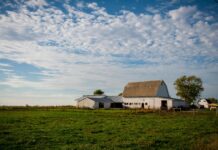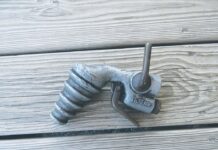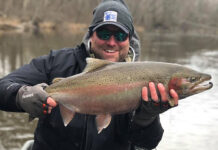
Even though the main log crib of the structure that would shelter both people and animals during the coming winter months was now largely completed, there was still a myriad of details that needed accomplished.
Enclosing the gables
With the chinking in place, the focus of attention turned to the gables at both ends of the structure. Because these were not enclosed by logs, the large triangular spaces, which had several stout timbers supporting the roof ends, were still standing wide open to the weather, birds, critters and whatever else might decide to make its way in. To enclose the gables was a task of relative ease — at least compared to the incredibly heavy work that had already been accomplished.
The gables would be covered by clapboards, or “clabbards,” as the term was often uttered in local lexicons. Clapboards were the equivalent of modern-day wooden lap siding, although they were handmade rather than machine sawn. To make clapboards was an almost fun job — if there was actually such a thing on the frontier — provided the right material was available.
The best wood for creating the needed siding was a large, straight-grained tree trunk (oak and maple were preferred) devoid of knots. Such material was beyond plentiful in the virgin forests of the Ohio Country where trees needed to grow straight and tall to compete for sunlight and their share of space in the seemingly limitless woodland canopy.
Making clapboards

With such a tree trunk at hand and laid on its side, the settler would use an axe to hew a flat surface on top of the trunk. He would then employ a tool called a “clapboard slick” to begin peeling off clapboards.
The clapboard slick, made of wrought iron by a blacksmith, was typically about two feet in length. The business end of the tool was a keenly sharpened chisel blade about 4 inches in width. From the chisel extended a sturdy handle terminating in a D-shaped grasp.
To work the slick, the user inserted the sharp edge of the chisel into the end grain of the log and pushed forward, walking the length of the log and peeling up the piece of siding as he went. He did this repeatedly, working his way down through the log board after board until he had created the number of pieces of siding needed. The clabbards were then sawn to length and nailed into place on the gables so that they overlapped one another.
Building a fireplace
After the structure was fully enclosed, the next biggest need was for a fireplace in which to do the family’s cooking. While stone was readily available for fireplace construction, plentiful clay deposits throughout the Ohio Country enabled brickyards to spring up quickly. Many settlers, however, made and fired their own bricks on site using make-do kilns of various types. Either way, the settler would construct a large walk-in fireplace with a sprawling brick or stone hearth. The large hearth would help prevent embers from reaching the adjacent wooden flooring and would allow space for hot, cast iron vessels to be maneuvered.
One feature common to almost all cooking fireplaces was the presence of at least one long wrought iron crane, from which to suspend cooking pots. The crane was hinged to the sidewall (or jamb) of the firebox, enabling it to swing out into the room where food could be placed in the cooking pots, and then swung into the firebox so that the vessels were positioned over the fire. Some fireplaces had cranes on both sidewalls. In instances where the crane was not built into the fireplace, the settlers would use a wrought iron standing crane on legs, which was portable.
Cooking fireplaces often integrated a storage space for logs that would be used in cooking, a so-called “beehive” brick oven for baking purposes and notches for the ends of a “lug pole” (made from a sturdy sapling) positioned across the throat of the chimney. On this could be hung various kinds of iron trammels that allowed pots to be moved closer to or farther from the fire. The fireplace and hearth were truly the heart of the house since so many of life’s daily activities centered around it.

Bedsteads
Then there was the question of bedsteads. Since the beautifully crafted antique cherry bed made by a relative had to be jettisoned along the trail months earlier during the trip in the Conestoga wagon as the oxen wearied dangerously, other beds had to be quickly fabricated. The fastest way to create a bed was to use a couple of sturdy saplings about six feet in length from which the bark had been stripped and the ends tapered with a drawknife. The ends of the saplings would be pounded into side-by-side holes bored into one of the logs with a hand auger, so they would be parallel to one another. At the opposite end, the bed rails would have been supported by sturdy Y-shaped branches mortised into the puncheon floor for support. The space between the two saplings would then be roped back and forth to support a tick mattress. This was a heavy fabric bag filled with leaves or straw for cushioning.
With the addition of some old quilts and blankets hung strategically here and there on the walls to cut down on drafts, and a ladder crafted for second-floor access, the barnhouse was essentially complete and the settlers were ready to tackle a myriad of other pressing concerns before the coming of winter.












